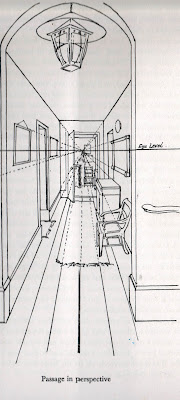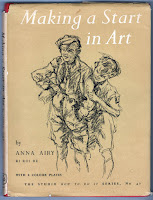 |
| Anna Airy, Verdure and Decay, watercolour |
She also wrote an instructional book called "Making a Start in Art
Here are some excerpts:
Eye level
 "You will find, by holding up your pencil or brush horizontally on a level with your eyes and extending it forward to arm's length, a mental horizontal line across your view. The boundaries of your picture having been decided by framing it with your hands, translate that mental observation into an actual light pencil line right across your paper, the eye level, and mark it E.L."
"You will find, by holding up your pencil or brush horizontally on a level with your eyes and extending it forward to arm's length, a mental horizontal line across your view. The boundaries of your picture having been decided by framing it with your hands, translate that mental observation into an actual light pencil line right across your paper, the eye level, and mark it E.L."Don't touch wet watercolour
"Do not touch wet watercolour—wait. However bad it looks when wet, it will not look so bad dry and you will get over the trouble more easily."
Half-closing the eyes
"It is very helpful to half-close your eyes every now and then when working; look through the lashes; this partially shuts out for the moment masses of detail that may be worrying you. This is not done with the idea that the detail may be left out to avoid trouble, but to let you see how subservient is that intricate detail to the picture seen as a whole."
Keeping things in proportion
"Do not be led away into making a lot of little measurements, each of which is in all probability a little wrong (and error multiplies): run your eye over your subject as a whole and take note of the proportion of big things to one another, remembering that the greater is bound to contain the less, so that if you get your few big proportions roughly correct, all the smaller objects will fall into their places without much difficulty."
Should we ignore detail?
"Never say, 'Oh! I don't see detail' and 'The detail doesn't matter.'"
How to paint a background around a complicated shape in watercolour
"Take a good brushful of the background colour and go carefully round your difficult flower petals first, leaving a real wet track. It will not dry in a hurry; if you wanted it to you would have to wait a long time! Then start your background wash at the top as you have done in previous examples, and continue it down until it meets the already wet colour round the flowers. When the washes meet you will have more wet colour than you want round the flower petals; take the squeezed-out brush, as before, and very lightly remove some: the remaining wet colour will probably settle itself quite comfortably. You must be neat-handed and careful! Or you can remove the extra moisture with a little corner of blotting paper, like taking off ink blots. Or you may effect the whole process by turning the work upside down."

Assorted thoughts
• "Our business is to be the eyes and the brain for other sorts of people."
• "Key your picture from its highest light, which we will assume to be, as it so often really is, the sky.
• "Don't look at the thing you're painting, look just beside it." (Attributed to James J. Shannon)
-----
Book on Amazon: Making a Start in Art
Previously: Anna Airy's Industrial Art








3 comments:
Wow, interesting advice - so specific. So clear.
I am not at a level of drawing that this would be something I could execute on, but I do dearly love to read about professionals offering up very technical and precise information. In today's "creative" space, most of the articles I see are about how to BE CREATIVE, which all turn out to be listicles with generic mantras.
When I was a young girl, around 9 or 10, I used to read my father's Naval Institute Proceedings magazines for a similar reason: aviators giving each other precise and methodical advice on how to improve their flying skills. I didn't understand any of it but loved that the monthly magazine existed. There is beauty in intense knowledge.
Some good (if not contradictory!) advice. I've come to the realization that squinting should be taught on day one and drummed in to the head every day thereafter until it becomes second nature. One of the biggest "secrets".
Susan, that's really interesting perspective. I always want to know the nuts and bolts and methodical advice.
Scott, we keep coming back to the basics in art training, seeing the same pointers in a new light.
Post a Comment